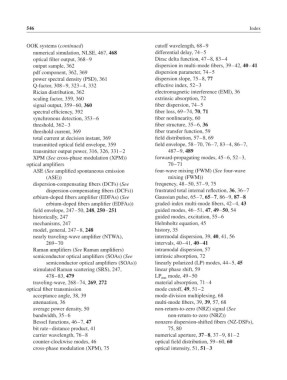Page 565 - Fiber Optic Communications Fund
P. 565
546 Index
OOK systems (continued) cutoff wavelength, 68–9
numerical simulation, NLSE, 467, 468 differential delay, 74–5
optical filter output, 368–9 Dirac delta function, 47–8, 83–4
output sample, 362 dispersion in multi-mode fibers, 39–42, 40–41
pdf component, 362, 369 dispersion parameter, 74–5
power spectral density (PSD), 361 dispersion slope, 75–8, 77
Q-factor, 308–9, 323–4, 332 effective index, 52–3
Rician distribution, 362 electromagnetic interference (EMI), 36
scaling factor, 359, 360 extrinsic absorption, 72
signal output, 359–60, 360 fiber dispersion, 74–5
spectral efficiency, 392 fiber loss, 69–74, 70, 71
synchronous detection, 353–6 fiber nonlinearity, 60
threshold, 362–3 fiber structure, 35–6, 36
threshold current, 369 fiber transfer function, 59
total current at decision instant, 369 field distribution, 57–8, 69
transmitted optical field envelope, 359 field envelope, 58–70, 76–7, 83–4, 86–7,
transmitter output power, 316, 326, 331–2 487–9, 489
XPM (See cross-phase modulation (XPM)) forward-propagating modes, 45–6, 52–3,
optical amplifiers 70–71
ASE (See amplified spontaneous emission four-wave mixing (FWM) (See four-wave
(ASE)) mixing (FWM))
dispersion-compensating fibers (DCFs) (See frequency, 48–50, 57–9, 75
dispersion-compensating fibers (DCFs)) frustrated total internal reflection, 36, 36–7
erbium-doped fibers amplifier (EDFAs) (See Gaussian pulse, 65–7, 65–7, 86–9, 87–8
erbium-doped fibers amplifier (EDFAs)) graded-index multi-mode fibers, 42–4, 43
field envelope, 247–50, 248, 250–251 guided modes, 46–51, 47, 49–50,54
historically, 247 guided modes, excitation, 55–6
mechanisms, 247 Helmholtz equation, 45
model, general, 247–8, 248 history, 35
nearly traveling-wave amplifier (NTWA), intermodal dispersion, 39, 40, 41, 56
269–70 intervals, 40–41, 40–41
Raman amplifiers (See Raman amplifiers) intramodal dispersion, 57
semiconductor optical amplifiers (SOAs) (See intrinsic absorption, 72
semiconductor optical amplifiers (SOAs)) linearly polarized (LP) modes, 44–5, 45
stimulated Raman scattering (SRS), 247, linear phase shift, 59
478–83, 479 LP mode, 49–50
mn
traveling-wave, 268–74, 269, 272 material absorption, 71–4
optical fiber transmission mode cutoff, 49, 51–2
acceptance angle, 38, 39 mode-division multiplexing, 68
attenuation, 36 multi-mode fibers, 39, 39, 57, 68
average power density, 50 non-return-to-zero (NRZ) signal (See
bandwidth, 35–6 non-return-to-zero (NRZ))
Bessel functions, 46–7, 47 nonzero dispersion-shifted fibers (NZ-DSFs),
bit rate–distance product, 41 75, 80
carrier wavelength, 76–8 numerical aperture, 37–8, 37–9, 81–2
counter-clockwise modes, 46 optical field distribution, 59–60, 60
cross-phase modulation (XPM), 75 optical intensity, 51, 51–3

